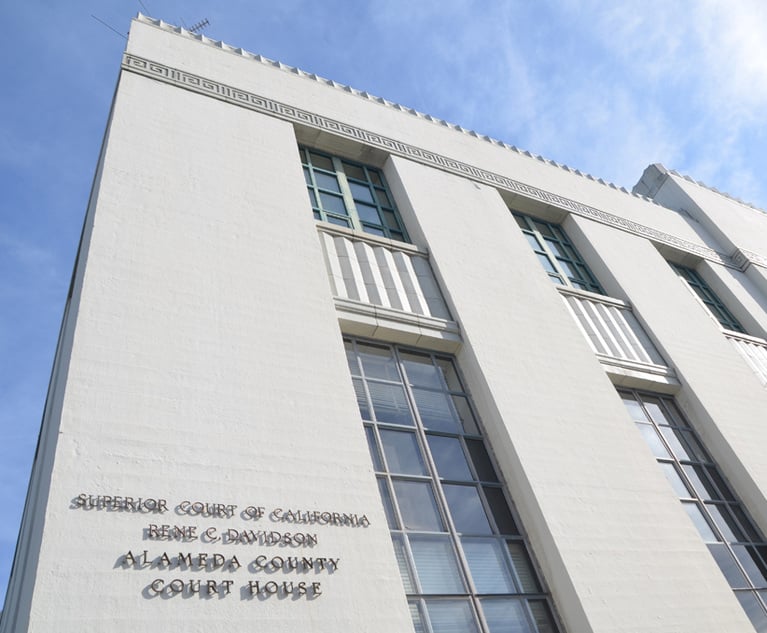Judiciary's Courthouse Wish List Will Go Under Microscope
Which courts end up with money could prove one of the biggest judiciary-related political battles of 2020 for judges, court administrators and lawmakers.
December 27, 2019 at 06:19 PM
6 minute read
 Sacramento State Capitol building on Capitol Way. Credit: Jason Doiy/ALM
Sacramento State Capitol building on Capitol Way. Credit: Jason Doiy/ALM
When California's legislature returns to session in January, the judiciary's annual campaign for budget money begins in earnest.
Chief on the judicial branch wish list will be hundreds of millions of dollars in funding for new courthouses to replace buildings that don't meet current seismic, safety or technology standards.
Which courts end up with that money could prove one of the biggest judiciary-related political battles of 2020 for judges, court administrators and lawmakers eager to see construction dollars go to their districts.
The Judicial Council this month sent a ranked list of 80 projects with a price tag of $13.2 billion to the Legislature. No one expects the governor and Legislature to allocate all of that money—or even most of it. Instead, the hope is that budget-writers will set aside funding for as many of those projects as possible, starting with the top of the list.
"Whether the list will hold up, I don't know," Martin Hoshino, the Judicial Council's administrative director, told reporters in December. "But there seemed to be a lot of deference to us before. But again, it's both a fiscal process as well as a political process."
A $5 billion bond construction program authorized by lawmakers in 2008 delivered some new courthouses around the state but not the 41 projects originally envisioned. State leaders diverted $1.4 billion in bond revenues during the recession years to pay for court operations and other state services. Money generated by fines and fees levied to cover the bond debt service has not materialized at the levels originally projected.
Sympathetic lawmakers released general fund money to pay for some of the unfunded projects. But they also asked judicial leaders to take a fresh look at its list of top construction needs.
How that final list of recommended projects was compiled is a subject of consternation or relief depending on which court leader is asked. Judiciary branch administrators released a draft ranking in August based on a host of factors, including the current buildings' seismic and fire safety levels, disability access and security features.
At the top of the list was a four-courtroom courthouse in Lake County. Facilities in San Bernardino, Kern and San Joaquin were also deemed the most "immediate" need. Kevin Brazile, presiding judge of the Los Angeles County Superior Court, the largest court system in the nation, expressed his dismay in a five-page letter that none of his court's projects were ranked in the top tiers of need.
"The court believes it is necessary to utilize either an alternate scoring tool to capture the complexity of providing justice in Los Angeles County or recommend a separate funding allocation methodology to address these complex and critical elements," Brazile wrote to a Judicial Council committee reviewing the project rankings.
Also unhappy were leaders from south Monterey County, where a small courthouse long planned for rural Greenfield plummeted in the rankings in favor of a new seven-courtroom building in more suburban, coastal Seaside. The city of Greenfield had already pledged $10 million and four acres for the building. Residents in the south county must now travel 50 miles or more to the courthouse in Monterey.
#Greenfield has an actual existing MOU for land donated to #JudicialCouncil worth $4-5M since 2010, whereas Seaside only makes commitment to SELL land worth many millions more. But Seaside somehow gets bumped up to #15 of 76, & Greenfield gets kicked towards the bottom at #41??? pic.twitter.com/hnIeaesuDQ
— Luis Alejo (@SupervisorAlejo) August 27, 2019
After hearing hours of testimony and advisory committee discussions, the judicial branch's administrators took a fresh look at the rankings. In November, they submitted a new list to the Judicial Council, one that put an emphasis on seismic safety.
The Lake County courthouse in Lakeport continued to top the list. But joining the highest "immediate need" category for the first time were two courthouses in Los Angeles County. Nine more Los Angeles projects were placed on the second-tier "critical need" list.
Brazile told the advisory committee he was "very grateful" that it had "fine-tune[d]" the list " to better address the needs of large courts."
Other courts' leaders experienced a different fate. The Judicial Council in 2007 had deemed Inyo County's historic courthouse to be a serious seismic risk. The draft list had ranked the southeastern county's project 13th in need. The revised list dropped Inyo's planned two-room courthouse to 28th.
"When the list came out … and we were able to evaluate the new criteria, somehow the building is now at moderate risk," Inyo court executive officer Pamela Foster told the advisory committee. "So I guess I should be happy that our building is now somehow safer than it was in 2007, but I don't think that that's probably the case."
The new list also bumped the Greenfield courthouse down to a third-tier "high" need. Seaside retained its "immediate" need label.
"The court explicitly did not prioritize either of those two projects," said Chris Ruhl, the executive officer of the Monterey County court. The court is now looking at expanding south county court services, including possibly reopening a shuttered King City courthouse, he said.
The Court Facilities Advisory Committee forwarded the final list to the Judicial Council, which endorsed it in November.
"If your position stayed the same and you were in the upper tier, you thought the council got it right," Hoshino said in December. "If your position changed and you weren't in the tier, the council got it wrong."
The Legislature is not required to stick to the list's priorities when choosing which projects to fund.
This content has been archived. It is available through our partners, LexisNexis® and Bloomberg Law.
To view this content, please continue to their sites.
Not a Lexis Subscriber?
Subscribe Now
Not a Bloomberg Law Subscriber?
Subscribe Now
NOT FOR REPRINT
© 2025 ALM Global, LLC, All Rights Reserved. Request academic re-use from www.copyright.com. All other uses, submit a request to [email protected]. For more information visit Asset & Logo Licensing.
You Might Like
View All

Fresh lawsuit hits Oregon city at the heart of Supreme Court ruling on homeless encampments
4 minute read

Trending Stories
- 1'Lookback Window' Law for Child Abuse Cases Constitutional, State High Court Finds
- 2Troutman Pepper Says Ex-Associate Who Alleged Racial Discrimination Lost Job Because of Failure to Improve
- 3Texas Bankruptcy Judge Withdraws Ethics Complaint Against Jackson Walker
- 4Apply Now: Superior Court Judge Sought for Mountain Judicial Circuit Bench
- 5Harrisburg Jury Hands Up $1.5M Verdict to Teen Struck by Underinsured Driver
Who Got The Work
J. Brugh Lower of Gibbons has entered an appearance for industrial equipment supplier Devco Corporation in a pending trademark infringement lawsuit. The suit, accusing the defendant of selling knock-off Graco products, was filed Dec. 18 in New Jersey District Court by Rivkin Radler on behalf of Graco Inc. and Graco Minnesota. The case, assigned to U.S. District Judge Zahid N. Quraishi, is 3:24-cv-11294, Graco Inc. et al v. Devco Corporation.
Who Got The Work
Rebecca Maller-Stein and Kent A. Yalowitz of Arnold & Porter Kaye Scholer have entered their appearances for Hanaco Venture Capital and its executives, Lior Prosor and David Frankel, in a pending securities lawsuit. The action, filed on Dec. 24 in New York Southern District Court by Zell, Aron & Co. on behalf of Goldeneye Advisors, accuses the defendants of negligently and fraudulently managing the plaintiff's $1 million investment. The case, assigned to U.S. District Judge Vernon S. Broderick, is 1:24-cv-09918, Goldeneye Advisors, LLC v. Hanaco Venture Capital, Ltd. et al.
Who Got The Work
Attorneys from A&O Shearman has stepped in as defense counsel for Toronto-Dominion Bank and other defendants in a pending securities class action. The suit, filed Dec. 11 in New York Southern District Court by Bleichmar Fonti & Auld, accuses the defendants of concealing the bank's 'pervasive' deficiencies in regards to its compliance with the Bank Secrecy Act and the quality of its anti-money laundering controls. The case, assigned to U.S. District Judge Arun Subramanian, is 1:24-cv-09445, Gonzalez v. The Toronto-Dominion Bank et al.
Who Got The Work
Crown Castle International, a Pennsylvania company providing shared communications infrastructure, has turned to Luke D. Wolf of Gordon Rees Scully Mansukhani to fend off a pending breach-of-contract lawsuit. The court action, filed Nov. 25 in Michigan Eastern District Court by Hooper Hathaway PC on behalf of The Town Residences LLC, accuses Crown Castle of failing to transfer approximately $30,000 in utility payments from T-Mobile in breach of a roof-top lease and assignment agreement. The case, assigned to U.S. District Judge Susan K. Declercq, is 2:24-cv-13131, The Town Residences LLC v. T-Mobile US, Inc. et al.
Who Got The Work
Wilfred P. Coronato and Daniel M. Schwartz of McCarter & English have stepped in as defense counsel to Electrolux Home Products Inc. in a pending product liability lawsuit. The court action, filed Nov. 26 in New York Eastern District Court by Poulos Lopiccolo PC and Nagel Rice LLP on behalf of David Stern, alleges that the defendant's refrigerators’ drawers and shelving repeatedly break and fall apart within months after purchase. The case, assigned to U.S. District Judge Joan M. Azrack, is 2:24-cv-08204, Stern v. Electrolux Home Products, Inc.
Featured Firms
Law Offices of Gary Martin Hays & Associates, P.C.
(470) 294-1674
Law Offices of Mark E. Salomone
(857) 444-6468
Smith & Hassler
(713) 739-1250






